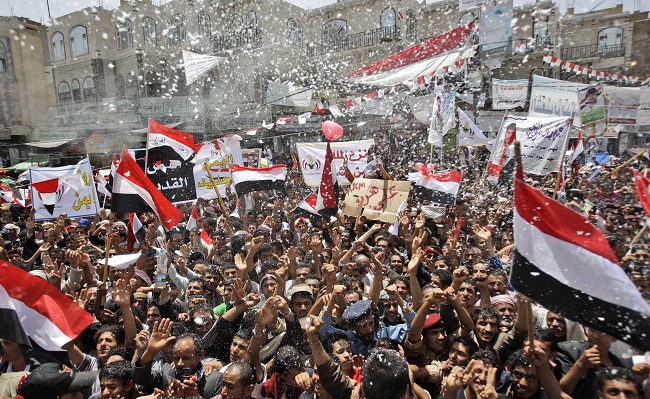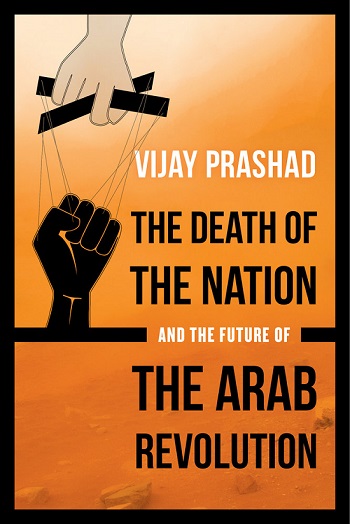
Reviewed: The Death of the Arab Nation and the Future of the Arab Revolution, by Vijay Prashad, University of California Press, 2016.
2011 seems like a long time ago. The streets and squares of cities and towns around the world were filled with people wanting a change towards a more socially just political and economic system. Beginning in the nations of Tunisia and Egypt with massive assemblies that eventually overthrew tyrants, the protests spread across the Arab world in what became known as the Arab Spring and were eventually given their own flavor in the cities of the United States as the Occupy Wall Street movement. One can reasonably argue the protests met their end with the violent repression waged against in Bahrain, Syria and on a lesser scale, the United States. In the wake of the Arab Spring, Egypt’s dictator Hosni Mubarak was temporarily imprisoned and popular elections were held. In Tunisia, a similar scenario unfolded. In Syria, a civil war erupted, while in Bahrain, nothing changed. As Vijay Prashad notes in his newest book The Death of the Arab Nation and the Future of the Arab Revolution, the insurrections grouped together as the Arab Spring are neither tidy nor finished. Indeed, their trajectory is being played out as I write.
Besides Prashad’s underlying premise that the revolution is ongoing, his approach discusses the fact of sectarianism in the region he calls west Asia and the role Washington’s policy of regime change plays in the region’s conflicts. In this discussion, he explores the connection between the two and how the latter informs and precipitated the former. In defining what he means by regime change, Prashad makes the point that his definition goes beyond the various military interventions by western militaries in the region to include the economic policies of the northern nations (enforced by agencies like the IMF and World Bank) that have created the conditions of neoliberalism that spawn inequality. It is this inequality, argues Prashad that neoliberal practices create and exacerbate; that impoverishes both rural and urban residents and provides those hoping for military action an excuse. In turn, this provides fertile ground for corruption and greed in government and violent discontent among those recently impoverished. Given that the Arab and West Asian Left are mostly unorganized in most countries, the discontented have turned to radical religious organizations for resolution.
 Yet, it is politics and not religion that is the basis of the battle(s) being fought. This is Prashad’s essential message. In this text, which he describes as a journalistic endeavor and not a scholarly treatise, Prashad takes on the Islamic State, the destruction of Libya and Syria, the Assad regime, the role of Turkey and other nations in stifling the secular left-leaning revolution in favor of a sectarian, socially conservative and capitalist one. In doing so, he laments the disintegration of the Arab nation as conceived by Nasser and his compatriots while explaining the rise of religious movements like the Muslim Brotherhood and Saudi Wahabbism. Shifting his narrative from anecdotal descriptions of his travels throughout the region to brief discourses on its history, Prashad has composed a readable and reflective discussion of the current reality in the global region we call the Middle East. Throughout, he reminds the reader of the regional and international power struggles that also are in play.
Yet, it is politics and not religion that is the basis of the battle(s) being fought. This is Prashad’s essential message. In this text, which he describes as a journalistic endeavor and not a scholarly treatise, Prashad takes on the Islamic State, the destruction of Libya and Syria, the Assad regime, the role of Turkey and other nations in stifling the secular left-leaning revolution in favor of a sectarian, socially conservative and capitalist one. In doing so, he laments the disintegration of the Arab nation as conceived by Nasser and his compatriots while explaining the rise of religious movements like the Muslim Brotherhood and Saudi Wahabbism. Shifting his narrative from anecdotal descriptions of his travels throughout the region to brief discourses on its history, Prashad has composed a readable and reflective discussion of the current reality in the global region we call the Middle East. Throughout, he reminds the reader of the regional and international power struggles that also are in play.
The narrative does not so much as blame any particular actors; although it is unsparing in its criticism of Washington and NATO and the manipulative role they have played and continue to play in the politics and economies of the region. Recognizing their failure to get what they hoped for after the invasion of Iraq, Prashad rightly points out that the murderous sectarian chaos that followed was not only okay with Washington/NATO, it was intensified by their policies. Likewise, a similar case can be made about Libya and Syria. As for the Islamic State, The Death of the Arab Nation and the Future of the Arab Revolution dissects its appeal to the angry and disenfranchised of the region and around the world, while also relating the seeds of its origin, the nature of its finances, and its relationship with governments and private benefactors among the region’s rich and powerful. When writing about Egypt, Prashad points out how the weakened pro-West liberals and progressives in the Tahrir Square movement were outnumbered and outmaneuvered by the more popular and better organized Muslim Brotherhood—a huge factor in the former’s decision to support the retrenchment of a pro-Israel, US supported military regime in Cairo. In Tunisia, meanwhile, the strength of various secular left-leaning unions was what kept the sectarian organizations from reaching a majority in the post-insurrection government of that nation. Yet, as Prashad makes clear, each and every population in the region is currently locked in a satanic cycle underwritten and manipulated by the capitals of the north. They are capitals whose interests are defined by profits, power and control of energy resources. The fate of the people living there is, for the most part, of secondary concern.
This is an important book. Although events on the ground change frequently and without apparent reason, The Death of the Arab Nation and the Future of the Arab Revolution combines historical context, insightful analysis and a sense of reason to the ongoing turmoil and struggle in the globe’s perennial hotspot. Prashad’s narrative moves swiftly across the geopolitical terrain like a NATO missile heading towards its target. Unlike that missile, however, Prashad’s objective is understanding, not destruction.
